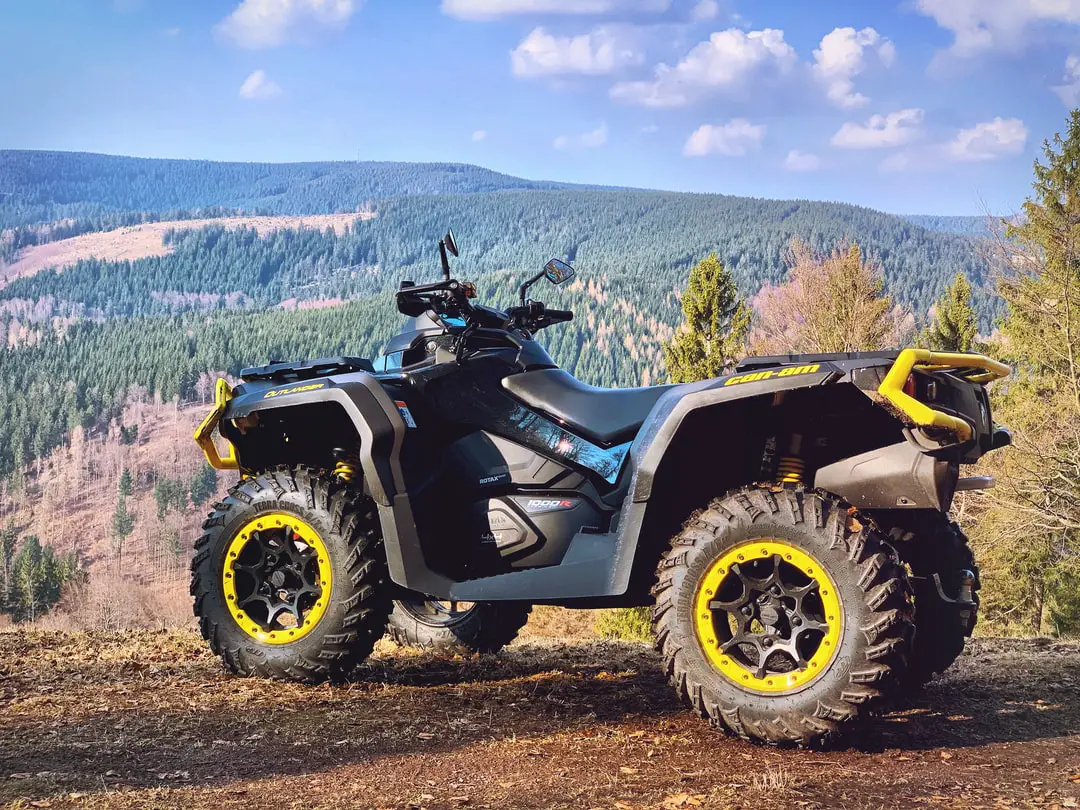ATV tire pressure varies depending on ATV size and tire type. However, most ATV tires have an ideal pressure rating of between 4 and 20 PSI (or 0.3 and 1.4 bar). You can use the information listed on your tire or your owner’s manual to discover the right level of pressure for your ATV’s tires.
Like automobile tires, ATV tires need to contain a specific amount of air to perform optimally. Tires that lose too much air can quickly fail to support vehicles and riders. They can also struggle to cross rugged terrains.
As such, ATV owners should always check their tire pressure before heading out on a trail or course. But what is normal tire pressure for ATV tires? And how do you fix ATV tire pressure?
In this article, we’ll answer those questions and discover everything you need to know about ATV tire pressure.
Table of Contents
What Is ATV Tire Pressure?
ATV tire pressure refers to the amount of air inside of a tire. This trapped air creates tension that keeps a tire inflated. If this air escapes, an ATV tire can quickly deflate and begin to collapse onto itself.
Several things can affect tire pressure, some of which are beyond a rider’s control. Understanding these impactful factors is essential to maintaining ideal tire pressure and avoiding accidental damage to your tires.
What Affects Tire Pressure?
Even the best ATV brands and highest-quality ATV tires can lose pressure over time. That’s because the air pressure in a tire is affected by several things, including the following:
- Temperature
- Weight
- Tire Condition
Understanding how these factors impact tire pressure can help you avoid underinflated or overinflated tires and their risks. So, let’s quickly touch on each one.
Temperature
Temperature affects air movement and density, which can cause noticeable pressure differences for your ATV tires. For example, warm temperatures cause air to expand, leading to overinflation.
Alternatively, cold temperatures can cause air to draw inward toward itself, leading to low pressure inside tires. If you’re riding an ATV during the winter or summer seasons, you’ll want to keep this effect in mind.
Weight
An ATV’s weight can significantly affect tire pressure. Large ATVs require larger tires that have higher pressures to support this weight. However, keeping several hundred pounds of machinery off the ground takes a toll.
A parked, unused ATV can slowly lose air pressure due to this weight. But riding around on rough terrain can accelerate air pressure loss. As such, riders should make a habit of checking tire pressure before each run.
Tire Condition
Older tires are more prone to losing air than brand-new ones. That’s because the rubber may be beginning to deteriorate and degrade.
That said, older tires should still be able to maintain air pressure for several days or weeks. So, if your ATV’s tires are consistently losing pressure after each filling, you may be experiencing signs of a leak.
Checking your ATV tires before each ride can help you spot early signs of tire damage. Of course, you’ll need to know what pressure rating you’re looking for during these inspections.
Normal Tire Pressure for ATV Tires
The standard tire pressure for ATV tires varies between 4 and 20 PSI. Larger recreational vehicles, such as utility terrain vehicles (UTVs), often need tires that feature higher pressures. This is because they’re heavier than ATVs.
ATV owners that suspect their tires might be underinflated or overfull shouldn’t rely on this average. That’s because every ATV tire has a recommended pressure rating.
For example, the 18-inch (46 cm) CST Ambush ATV Tire has a recommended PSI of 5. This all-terrain tire is designed for smaller ATVs, as well as motorcycles. As such, its PSI is at the lower end of the range.
But the hefty, 30-inch (76 cm) GBC Dirt Commander Tire needs to be inflated to an astounding 20 PSI. This amount of air pressure is ideal for larger ATVs as wells as some UTVs.
You can find this recommended PSI listed on your tire’s sidewall. From there, all you’ll need to maintain an ATV’s tire pressure is an air pump and a gauge.
How to Fix ATV Tire Pressure
Fixing ATV tire pressure problems is a relatively straightforward process. You’ll only need to follow five simple steps:
- Determine the Recommended Pressure
- Find or Buy an Air Pump
- Fill the Tire
- Check the Tire Gauge
- Maintain Tire Pressure
Let’s quickly review these steps to help you get your tires back into tip-top shape. Naturally, the first thing you’ll want to do is determine the appropriate air pressure rating for your vehicle’s tires.
Determine the Recommended Pressure
Do you know what your ATV tire’s recommended PSI rating is? If not, you won’t be able to proceed. But, luckily, discovering your tire’s PSI only take a few seconds.
Every ATV tire should have a listed PSI along the sidewall. If yours does not, it may be a sign that your tires are well-worn and ready for replacement.
Find or Buy an Air Pump
Pumping your ATV tires by hand can be nearly impossible. As such, you’ll likely need a mechanical air pump to get the job done. Many gas stations and automatic car washes have affordable, coin-operated air pumps.
You could also choose to visit your local mechanic and ask to use their air pump. However, they may charge for this service.
If you own multiple ATVs, purchasing an air pump for at-home use could be the most affordable and convenient solution.
Fill the Tire
Once you’ve got your air pump ready to go, it’s time to unscrew the tire valve caps and connect the pump hose to the valve. From there, it’s only a matter of waiting and watching the air pressure gauge.
Check the Tire Gauge
As you’re filling your tire, you should also keep an eye on the air pressure gauge. When the reading or instrument needle reaches the ideal PSI, it’s time to shut off the air and replace the valve caps.
Maintain Tire Pressure
The last thing you’ll need to do is maintain your ATV tire pressure. To do this, you can utilize a handy tire pressure gauge. Simply connect this gauge to your tires each time you’re preparing to ride.
Regular pressure inspections can prolong the life of your ATV tires and help prevent accidents and injuries during your rides.
Follow Tire Pressure Recommendations
ATV tire pressure refers to the amount of air inside of a tire. Too little pressure results in flat tires and sluggish journeys. Riding with a deflated tire can also cause significant and long-lasting damage to the tire.
Fortunately, fixing ATV tire pressure is a straightforward process. First, you’ll need to determine the ideal pressure for your vehicle’s tires. After that, you can use an air pump and gauge to fill them to that level.
If you enjoyed this article, be sure to check out these related ATV articles now!










